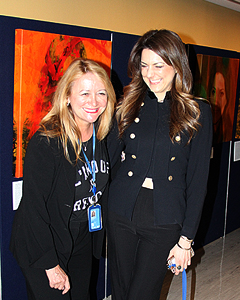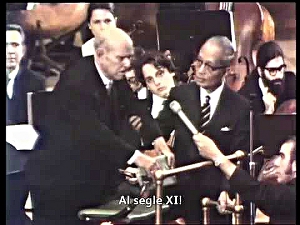
Do you know?
UNknown UN History
By Pat Duffy
 Artist Marlene Tremblay with portrait subject Melanie Randisi of UNCA |
Has the “New York woman” ever been honoured at UN Headquarters? The answer is yes! -- thanks to Canadian pinto-photographer Marlene Tremblay, who in March 2017 honoured 15 New York women in an exhibition at UN Headquarters for Women’s History Month. Ms Tremblay’s 15 portraits spotlight women who hail from all parts of the globe: from Tunisia, to China, to Colombia, to Iraq and more. Their professions are equally diverse and include UN staff, artist, psychotherapist, ecological designer, restauranteur, international student counselor. Artist Tremblay sought to answer the question, “What makes the New York City woman so powerful?” |
Back in 2009, Ms Tremblay, who works in the Office of the Spokesperson for the UN Secretary-General, was herself a newcomer to New York.
In New York City for the first time, her friendships with other female newcomers inspired her. Many felt a new freedom to realize and develop their potential and dare to reach for long-hoped-for goals.
Ms Tremblay’s ‘portrait project’ itself expanded this sense of mutual support. As one of the portrait subjects, Melanie Randisi, put it, “All of us bonded through Marlene’s portrait project. We sat together and told our stories. We empathized with one another’s struggles. Though they might be different, they are struggles any of us could be facing at any time: struggles in career, creativity, health, relationships.”
Ms Randisi, who works with journalists based at the United Nations, organizes events at UN Headquarters on issues of the day.
The women depicted in the portraits had inspired the artist with their strength, talents, risk-taking, and belief in life.
Ms Tremblay created the portraits using “pinto-photography”, which combines photography and painting, along with an overlay of natural images, such as flowers or effervescent bubbles. A process as unique as the artist’s subjects, it aims to bring forth the inner essence of each woman.
Female friendship and the sharing of aspirations and struggles created a supportive space that propelled all towards realizing their dreams in the “city of dreams”, New York.
![]()
|
Does the UN have an official song? Does the United Nations have its own official “anthem” or song? While there is no “mandated anthem”, a “Hymn to the United Nations” was written by the great cellist and composer, Pablo Casals. The Catalonian maestro wrote the hymn in honour of the Organization’s twenty-fifth anniversary in 1971. It was performed on United Nations Day at UN Headquarters. The words to the hymn were written by poet W.H. Auden of the United Kingdom. |
 Pablo Casals and U Thant, UN, 1971 |
While Casals greatly liked the ideas
contained in the preamble, there was no way he could put music to such a
document. The task to write an appropriate poem, based on the theme of peace
and ideals enshrined in the preamble, fell on W.H. Auden, then regarded as
the greatest living English poet. When a representative of the
Secretary-General approached the poet, he immediately agreed to write the
poem. In three days’ time, Auden finished writing “A Hymn to the United
Nations”, which was then set to music by Casals.
On 24 October 1971, the Orchestra of the
Festival Casals, with Casals as conductor, presented the hymn in a première
performance at UN Headquarters.
To listen to “Hymn to the
United Nations” and see the words, click here:
![]()
Do you know the origin of the name, “United Nations”?
 United Nations Headquarters, New York |
The name comes from a poem,
“Childe Harold’s Pilgrimage”, written in 1818 by the British Romantic
poet, George Gordon, Lord Byron. Byron’s poem contains the lines: Millions of tongues record thee, and anew Their children’s lips shall echo them, and say, 'Here, where the sword united nations drew, Our countrymen were warring on that day !' |
The story goes that Winston Churchill, a great lover of poetry, recited the lines to Franklin Roosevelt and his granddaughter on a visit to Washington, D.C. in 1944. After, Byron’s more poetic “United Nations” came to replace the originally proposed name “Associated Nations”
In the poem “Childe Harold”, among other themes, Byron was writing about all the bloodshed in the many wars in Europe.
With this we are reminded that a great many (if not all) human creations start with poetic and artistic vision. And with that thought we will conclude with another of Byron’s poetic lines:
“a drop of ink may make a million think.”